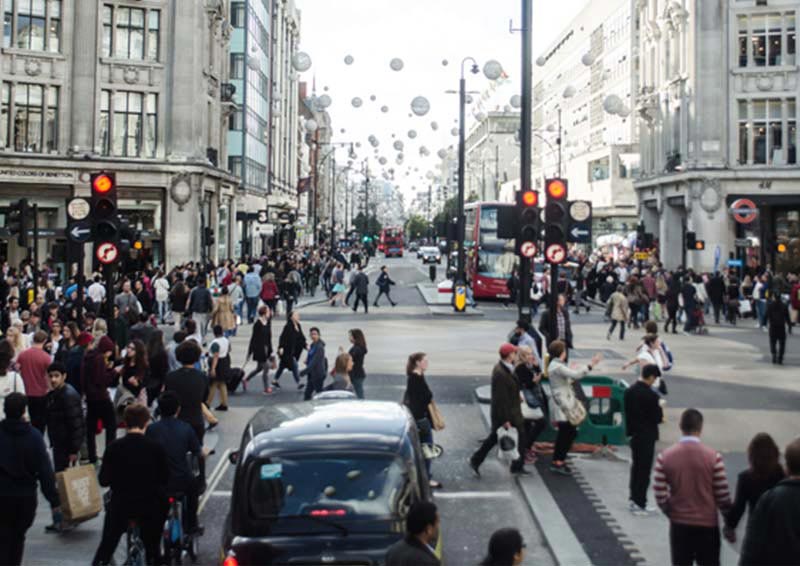Built environment
The term ‘built environment’ refers to aspects of our surroundings that are built by humans, that is, distinguished from the natural environment. It includes not only buildings, but the human-made spaces between buildings, such as parks, and the infrastructure that supports human activity such as transportation networks, utilities networks, flood defences, telecommunications, and so on.
The Construction Industry Council (CIC) suggest that the built environment, '...encompasses all forms of building (housing, industrial, commercial, hospitals, schools, etc.), and civil engineering infrastructure, both above and below ground and includes the managed landscapes between and around buildings.'
The Centre for Digital Built Britain defines the built environment as; 'All forms of buildings (residential, industrial, commercial, hospitals, schools), all economic infrastructure (above and below ground) and the urban space and landscape between and around buildings and infrastructure.' Ref The Gemini Principles, December 2018.
'Built environment' can be a useful term, as other descriptions such as ‘buildings’, ’civil engineering’, ‘construction’, and so on, do not fully capture the extent of our human-made environment, and separating the subject into its component disciplines fragments what should be considered a holistic endeavour. However the term itself is not widely used and is easily misunderstood.
As the population increases, and there is greater pressure for sustainable development, the requirements we have from the built environment are becoming more demanding. Over half the planet's population now lives in cities and this figure is predicted to rise to more than 70% by the second half of the century, a figure made even more startling by the fact that the human population will have increased by two billion in the same time-frame.
There is broad agreement that densely populated urban areas should be more sustainable than less concentrated rural settlements. However, whilst around 50% of the global population lives in cities, they account for more than 75% of the consumption of non-renewable resources, and create around three quarters of global pollution.
In part, this is because it is not always clear who is responsible for the built environment. It is an interdisciplinary field, with involvement form architects, engineers, town planners, landscape designers, urban designers, central and local policy makers and so on, but there is often an absence of leadership. It can seem that our built environment simply develops organically, through the constant turnover of stand-alone developments.
In his foreword to the Global Report on Human Settlements 2009, Planning Sustainable Cities Ban Ki-Moon, Secretary General of the United Nations wrote, “The major challenges of the twenty first century include the rapid growth of many cities and the decline of others, the expansion of the informal sector, and the role of cities in causing or mitigating climate change. Evidence from around the world suggests that contemporary urban planning has largely failed to address these challenges.”
Effective development of the built environment depends on a sustained commitment to a clear course of action over the short, medium and long term:
- Unified leadership.
- A clear inspirational vision.
- A set of well-defined strategies and objectives.
- Clear communication
- The creation of an appropriate and acceptable governance model.
- The development of a business case and economic appraisals to assess the impacts of development.
- A clear understanding of urban development, transport and infrastructure strategies and regeneration models.
- A thorough grasp of how technology can be integrated into our built environment.
- An appreciation of current and emerging best practice in the use of smart systems in services, infrastructure, and buildings.
- An appreciation of context and an understanding of the interests of stakeholders, local culture and customs.
- An understanding of the ownership, safety, security and use of data as well as funding models for new infrastructure.
NB Digital Twin Toolkit, Developing the business case for your digital twin, published by cdbb in February 2021, suggests the built environment is made of:
- All economic infrastructure: transport, energy, telecoms, water, waste systems
- All social infrastructure: hospitals, education facilities, prisons, …
- Residential, commercial and industrial buildings
- And it’s interface with the natural environment.
See also: Elements of the built environment.
[edit] Related articles on Designing Buildings Wiki
- Architecture.
- Building.
- Building Back Better: Social impact.
- CIAT agrees to collaboration arrangement with CIB.
- Elements of the built environment.
- Environment.
- External environment.
- Infrastructure.
- Internal environment.
- Masterplanning.
- Megacity.
- Must cities grow to compete?
- Natural environment.
- Place.
- Placemaking.
- Smart cities.
- Society.
- Thermal environment.
- Types of building.
- Types of land.
- Urban.
- Urban design.
- Urban fabric.
- Use class.
Featured articles and news
Gregor Harvie argues that AI is state-sanctioned theft of IP.
Heat pumps, vehicle chargers and heating appliances must be sold with smart functionality.
Experimental AI housing target help for councils
Experimental AI could help councils meet housing targets by digitising records.
New-style degrees set for reformed ARB accreditation
Following the ARB Tomorrow's Architects competency outcomes for Architects.
BSRIA Occupant Wellbeing survey BOW
Occupant satisfaction and wellbeing tool inc. physical environment, indoor facilities, functionality and accessibility.
Preserving, waterproofing and decorating buildings.
Many resources for visitors aswell as new features for members.
Using technology to empower communities
The Community data platform; capturing the DNA of a place and fostering participation, for better design.
Heat pump and wind turbine sound calculations for PDRs
MCS publish updated sound calculation standards for permitted development installations.
Homes England creates largest housing-led site in the North
Successful, 34 hectare land acquisition with the residential allocation now completed.
Scottish apprenticeship training proposals
General support although better accountability and transparency is sought.
The history of building regulations
A story of belated action in response to crisis.
Moisture, fire safety and emerging trends in living walls
How wet is your wall?
Current policy explained and newly published consultation by the UK and Welsh Governments.
British architecture 1919–39. Book review.
Conservation of listed prefabs in Moseley.
Energy industry calls for urgent reform.
























